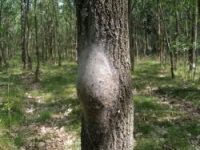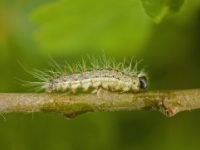Page contents
- About the oak processionary moth
- Health risks
- Health advice
- Life cycle of the moth
- Preventing the spread
- Report sightings
About the oak processionary moth
 The oak processionary moth (Thaumetopoea processionea) is a pest that has been found in Surrey. The caterpillar lives on oak trees and poses a risk to human and animal health.
The oak processionary moth (Thaumetopoea processionea) is a pest that has been found in Surrey. The caterpillar lives on oak trees and poses a risk to human and animal health.
You can view the distribution of the Oak processionary moth (Thaumetopoea processionea) in Surrey on the Forest Research website.
Please note: All sightings of the oak processionary moth should be reported to the Forestry Commission immediately. See below for more information about how to report a sighting. The Forestry Commission does not fund control, this is up to the tree owner and not a legal requirement.
It is important that you do not touch the larvae or caterpillars or disturb any nests, nor should you tread on any caterpillars on the ground as that will detach the hairs which cause health problems.
Health risk
The caterpillar of this moth emerges in April every year and their tiny hairs contain a protein which can cause itchy skin rashes and less frequently, eye and throat irritations and breathing difficulties in people and animals.
Pets are also affected and must be kept away from the nests and caterpillars.
Health advice
If you do come into contact with the larvae or caterpillars by accident, please follow the health advice on the National Health Service (NHS) website. If you have an itching skin rash and/or conjunctivitis or other symptoms, contact your GP, or call NHS Direct on 111. The call is free from any phone.
Life Cycle
March and April - nests should not be approached at any time.
May to July - this is the greatest risk period when the caterpillars are most numerous and are active around the tree or on the ground.
Preventing the spread of oak processionary moth (OPM)
Taking action will depend in which zone of the three OPM management zones your affected trees are in.
Government action and support for affected owners depends on which one of the three OPM management zones the affected trees are in. Guidance on the zones can be found in The Oak Tree Owners' OPM manual, but these are subject to change as the Forestry Commission review each year.
Local councils may also use their public health and safety powers to require removal of OPM on private or third party trees.
 Report any sightings immediately
Report any sightings immediately
Make sure you have correctly identified the species. Find out how to identify an oak processionary moth caterpillar on the Oak processionary moth (Thaumetopoea processionea). Use the Forestry Research's Tree Alert online reporting form. (Forest Research is the research agency of the Forestry Commission).
If you are unable to use the form, please use one of the following contact options:
- email your report to opm@forestrycommission.gov.uk
- telephone it to 0300 067 4442, providing as much detail as to the location as possible.

